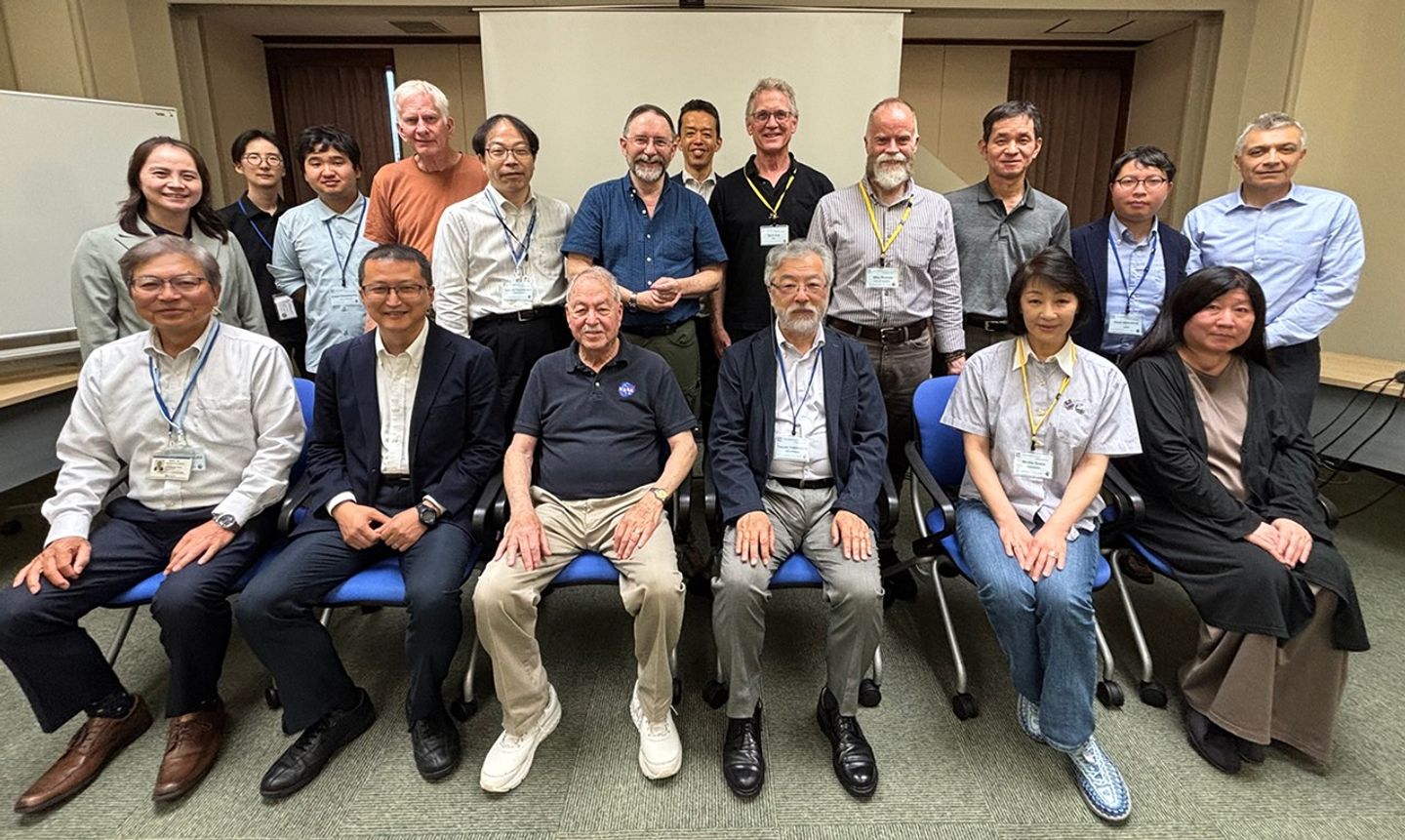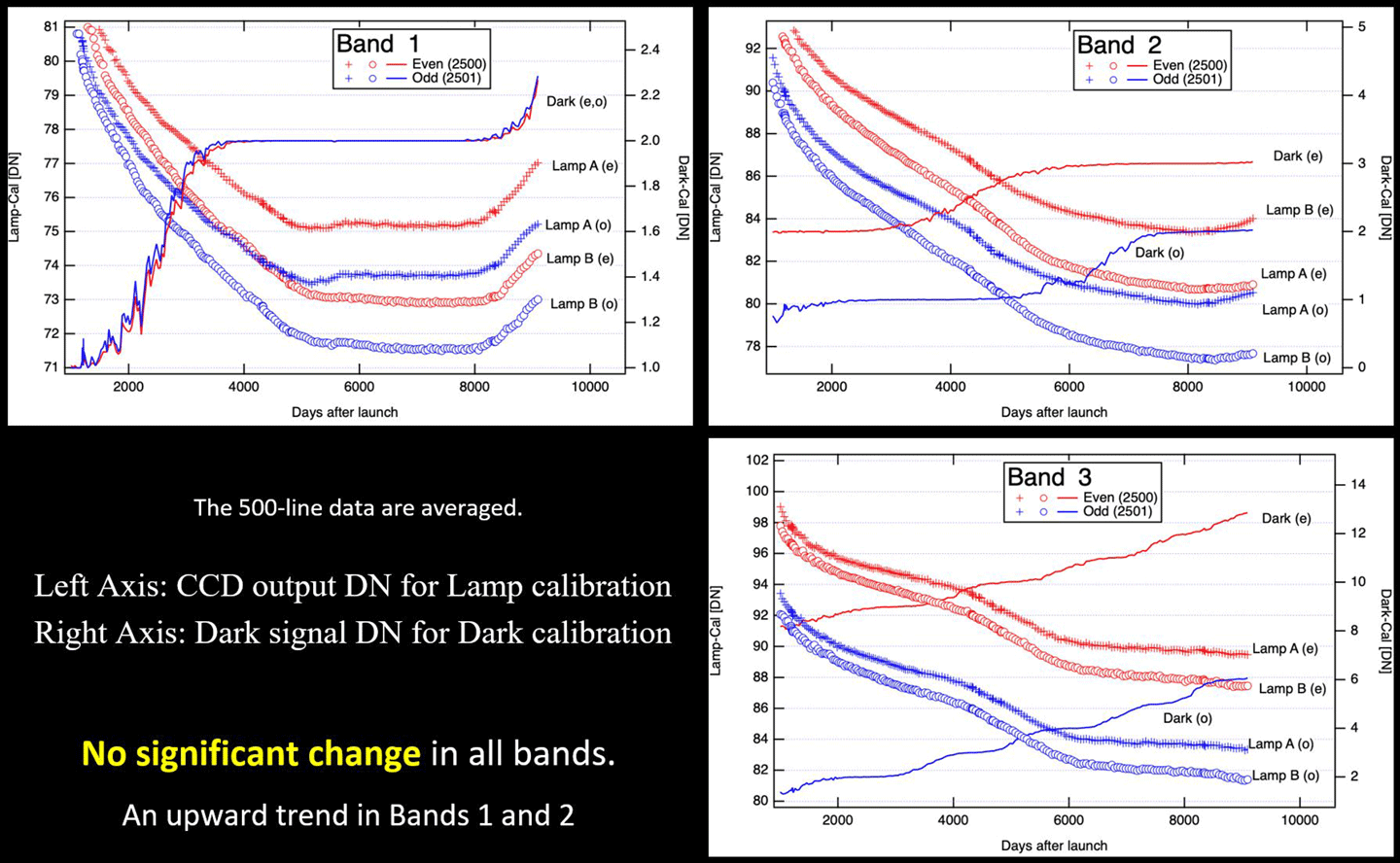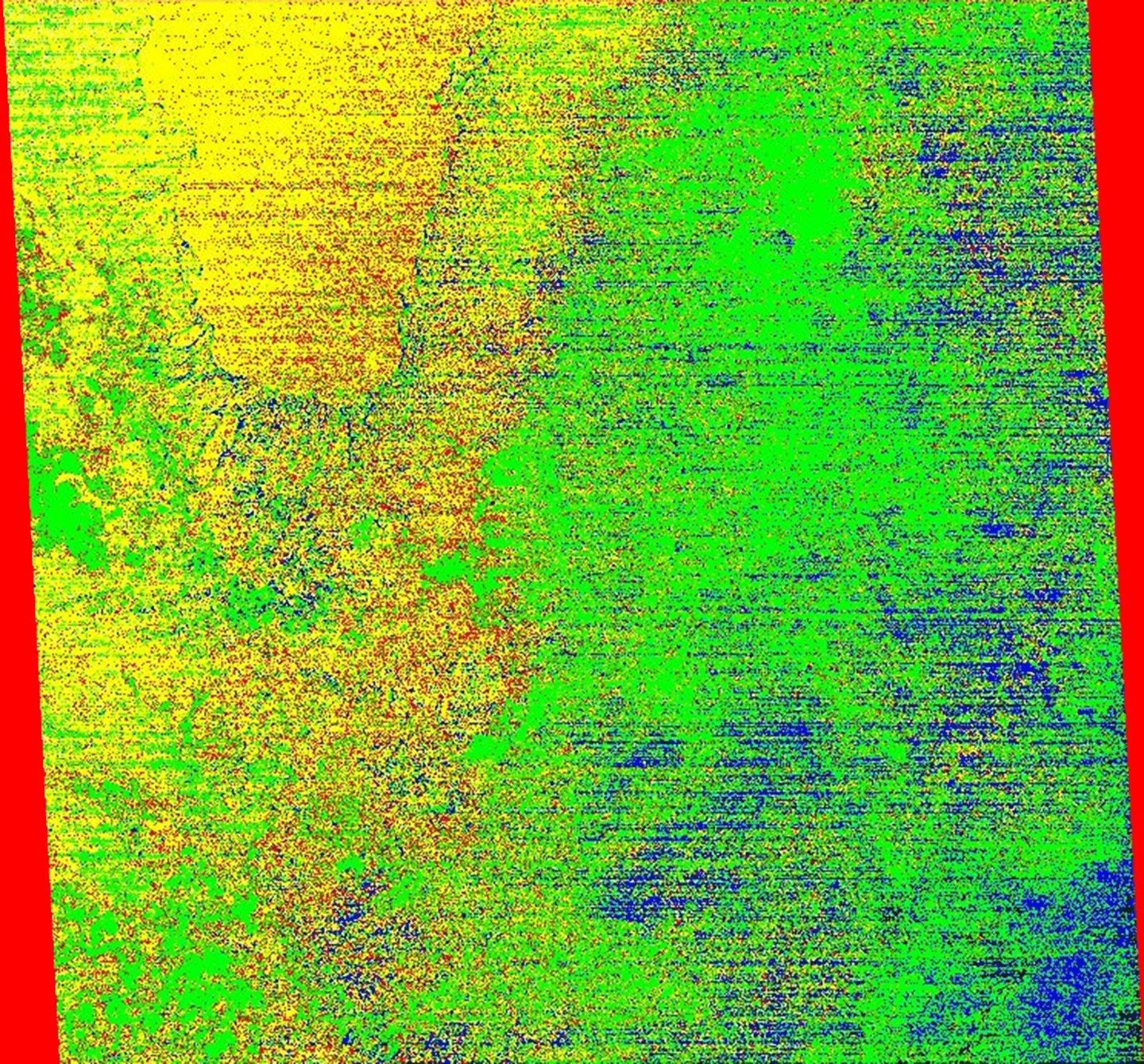
12 min read
Introduction
The Advanced Spaceborne Thermal Emission and Reflection Radiometer (ASTER) Science Team (ST) organized a three-day workshop that took place June 9-11, 2025, at the Japan Space System's (JSS) offices in Tokyo, Japan. About 25 people from Japan and the United States participated during the in-person meeting - see Photo 1.
U.S. participants included representatives of NASA/Jet Propulsion Laboratory (JPL); two universities - University of Arizona (UA) and University of Pittsburgh (UPitt); and Grace Consulting. Japanese participants represented JSS, the Geologic Survey of Japan (GSJ), National Institute of Advanced Industrial Science and Technology (AIST), National Institute for Environmental Studies (NIES), and the Remote Sensing Technology Center of Japan (RESTEC). Participants from Ibaraki University (IU), Nagoya University (NU), University of Tokyo (UT), and University of Tsukuba (Uts) also joined.

The main objectives of the 54th ASTER STM were to:
- discuss impacts of the proposed NASA budget reductions for Fiscal Year (FY) 2026;
- respond to plans for future impacts on ASTER from possible power reductions on the Terra platform;
- receive updates on data acquisition status, data calibration and validation (cal/val) activities, data distribution plans, and applications using ASTER observations; and
- discuss the end-of-mission plans for Terra and ASTER and archive documentation requirements.
The remainder of this article summarizes the highlights from the meeting, which includes an overview of the opening plenary session and summaries of the four working group sessions. A brief review of the closing plenary, which included summary reports from the chairpersons of all working groups, rounds out the report, followed by some overall concluding thoughts.
Opening Plenary Session
Yasushi Yamaguchi [NU-Japan ASTER ST Lead] and Michael "Mike" Abrams [JPL-U.S. ASTER ST Lead] welcomed participants and reviewed the agenda for the opening plenary and the schedule for the working group sessions.
Abrams presented highlights of science results based on ASTER data. He also discussed some issues that Woody Turner [NASA Headquarters-ASTER Program Scientist] had raised, including NASA's response to the President's proposed fiscal year (FY) 26 budget and the status of FY25 funding. Abrams reported that Terra passivation is currently scheduled for February 2027 and described Terra's power status. [UPDATE: If the President's proposed FY26 budget goes into effect without modification by Congress, the three Flagship missions will enter accelerated Phase F (closeout); Terra passivation would start in November 2025 and be complete by March 2026.]
Abrams reviewed the status of the Terra spacecraft, showing slides provided by Jason Hendrickson [GSFC]. The Flight Operations Team staffing remains constant. Science data capture for ASTER remains above 99%. The impact of the shunt failure on November 28, 2024 required the safe halting of the instrument. Visible-near-infrared (VNIR) observations resumed in mid-January, and thermal infrared (TIR) observations resumed in mid-May. Collision avoidance events continue to be part of normal operations.
Hitomi Inada [JSS] provided a status report on the ASTER instrument. Many of the monitored components (i.e., VNIR pointing motor) are beyond their original useful life in orbit, but the aging hardware shows no signs of wearing out or a decrease in performance. She showed data that indicated that the temperature and current telemetry trends remain stable.
Abrams presented ASTER product distribution statistics provided by Cole Krehbiel [Land Processes Distributed Active Archiver Center (LP DAAC]). The ASTER Digital Elevation Model continues to be the most ordered product among all users of ASTER data. As defined by the ST at the last meeting, most ASTER data products [e.g., Version 4 (V4) products] are being created and placed in a searchable/orderable archive that can be accessed through NASA's Earthdata tool. Abrams reported that the LP DAAC started producing these files in January 2025 and will be finished before August 2026.
Koki Iwao [GSJ] presented AIST's product distribution statistics. Over 4.7 million scenes have been acquired and processed to Level 1A (L1A) since June 10, 2025. AIST continues to distribute ASTER's pseudo-natural color scenes in keyhole mark-up language (KML - a file format used to display geographic data) and scene-based Digital Elevation Models. The largest number of users of Japanese products are from the United States.
Tetsushi Tachikawa [JSS] summarized the status of ASTER observations since the beginning of the mission. He reported that all of the global observation programs are functioning normally, acquiring data as planned. Updates to the observation programs will be considered by this week's working groups. Tachikawa also added that the change of the orbit repeat - after Terra's October 2022 exit from the Morning Constellation - has been accommodated in the ASTER scheduler.
Abrams presented a report on behalf of Simon Hook [JPL], who was unable to attend the meeting. Hook's information provides a status update for the multispectral TIR instrument on NASA's ECOsystem Spaceborne Thermal Radiometer Experiment on Space Station (ECOSTRESS) mission. Abrams also spoke about NASA's future Surface Biology and Geology (SBG) mission, which is part of the planned Earth System Observatory.
Applications Working Group
The applications session provided a sampling of how ASTER data are used. A few examples are highlighted below. The second half of the session was devoted to a discussion of end-of-mission documentation requirements. This included a review of the NASA guiding document and sharing of existing documents.
Michael Ramsey [UPitt] presented work on forecasting volcanic activity with the ASTER long-term archive. His team developed a statistical detection code to extract accurate temperature anomalies for five test volcanoes over 25 years. They used these results to train a deep learning approach for anomaly detection in future TIR data. The method showed 73% success for Piton del la Fournaise volcano, Réunion island, and near 100% success for Sheveluch volcano, Kamchatka Krai, Russia.
Miyuki Muto [IU] reported on waste volume changes in 15 open landfills in developing countries using more than 20 years of ASTER time-series digital surface models - see Figure 1. The method was found to be consistent with reports using synthetic aperture radar (SAR) data, which dates to 2016. Thus, ASTER can provide a longer time series for future optical or radar studies.

Mike Abrams presented the 25-year history of ASTER data applied to geologic mapping and mineral exploration. He explained how the first published papers appeared a few years after launch and validated the unique mineralogical information contained in the ASTER data. Over the following 20 years, several reports from mineral exploration companies announced the discovery of gold, chromite, and lithium deposits, which were found largely based on analysis of ASTER data.
Calibration/Validation Working Group
The Calibration/Validation (cal/val) working group is responsible for monitoring the radiometric and geometric performance of ASTER's VNIR and TIR instruments. Three different cal/val techniques are used including: analysis of onboard calibration lamps, comparison with onboard blackbodies, and measurements of pseudo-invariant ground targets during field campaigns. The L2 software algorithms are being updated for the final, archival processing which is anticipated to be completed in May 2026.
Bjorn Eng [JPL] reported that the newest version of the L2 algorithm for ASTER VNIR and TIR cal/val was delivered to the LPDAAC for ingest and testing. Eng explained how the new software includes Modern-Era Retrospective Analysis for Research and Applications, Version 2 (MERRA-2) data, which allows users to create atmospheric profiles for temperature, pressure, water vapor, and ozone. MERRA-2 is an improvement - both spatially and temporally - over the National Centers for Environmental Prediction's Global Data Assimilation System that is used in the original MERRA. The new L2 production algorithms were validated, and the LP DAAC began incorporating the algorithms into the static archive in January 2025.
Mike Abrams presented on behalf of Cole Krehbiel [LP DAAC] and reported on the assessment of geometric performance of the L1 processing software, which was updated to the new Landsat ground control point library. He also presented an improved global digital elevation model. The ASTER final processing campaign uses the improved control point library.
Satoru Yamamoto [GSJ] presented updates to the calibration trends of the onboard VNIR lamps. Two onboard calibrations were performed on September 20, 2024 and November 8, 2024. Several analyses of the calibration lamps showed no significant change in the data trends - see Figure 2. The signal-to-noise ratios are still greater than the requirement of 140.

Soushi Kato [RESTEC] presented results from his September 2024 field campaign in Nevada and Utah. The campaign was marked by clear weather during ASTER's day and night overpasses. Kato compared his in situ TIR measurements with the standard ASTER temperature products from the LP DAAC. The agreement for the five AESTER TIR bands was within ± 1.5 K.
Hideyuki Tonooka [IU] presented the results of his TIR field calibration campaigns at the same time and location as those conducted by Kato (described in previous presentation summary). Additionally, he reported that several calibration campaigns conducted at Lake Kasumigaura, Japan were cancelled due to cloudy weather, which led to the suspension of ASTER data acquisition. Tonooka compared his in situ TIR measurements with the standard ASTER temperature products from the LP DAAC. The agreement for the five ASTER TIR bands was within ± 1.3 K, except for band 10 at the Utah site where the discrepancy was -2.3 K.
Temperature-Emissivity Working Group
This group focuses on ASTER's kinetic temperature and emissivity products, as well as application of these products and review of the nighttime TIR global mapping program status.
Mike Abrams presented his analyses of the ASTER Level-2 Surface Kinetic Temperature Product (AST_08) for a nighttime scene acquired over Lake Tahoe, CA. He compared the on-demand MERRA-2 product from NASA's Global Modeling and Assimilation Office with the archive-produced product. The comparison showed that the two products were identical, pixel-by-pixel. Abrams conducted a second analysis to compare the archived MERRA_2 AST_08 product with the on-demand Moderate Resolution Imaging Spectroradiometer (MODIS) AST-08 product to assess the difference in temperature due to improved MERRA-2 atmospheric parameters. The MERRA-2 product had lower temperature values for higher elevations and higher values for lower elevations with more column water vapor - see Figure 3. This result is physically correct and validates the improvement using MERRA-2 atmospheric data.

Hideyuki Tonooka discussed the status of installation of the JPL radiometer at Lake Kasumigaura. The plan is to mount the radiometer on an existing observation in the middle of the lake. The radiometer will be operated jointly by JPL and IU. The installation is planned to start in the Summer 2025.
Tetsuchi Tachikawa reviewed the status of the current Thermal Global Mapping acquisition program to acquire cloud-free TIR nighttime images over most of the Earth's land surface. He explained that the program is refreshed every year, with most recent refresh beginning May 2025.
Operations and Mission Planning Working Group
The Operations and Mission Planning Working Group oversees and reviews the acquisition programs executed by the ASTER scheduler. Because ASTER data acquisitions have to be scheduled every day to accommodate ASTER's average 8% duty cycle, ST members developed an automatic program to select 600-700 daily scenes from the possible 3000 plus images uploaded in the request archive.
Tachikawa reviewed the status of acquisition scheduling. Urgent observations receive the highest priority and can be scheduled close to acquisition time. Approximately 70 scenes are programmed per month - with over 95% acquisition success. By contrast, global mapping data acquisitions receive the lowest priority and are used to fill in the scenes for the daily quota. He explained that the goal of the ASTER is to have the instrument acquire at least one cloud-free image for every place on Earth. Due to persistent cloud cover, success is typically ~85% after several years, at which time the program is restarted. Tachikawa next gave short updates on three other acquisition programs that focus on islands, volcanoes, glaciers, and cloudy areas, respectively. The global volcano image acquisition program will continue with no change to the observation parameters. Acquisition of images of islands and over cloudy areas will also continue in current form. The global glacier acquisition program will be modified to change the VNIR gain settings to optimize images over snow and ice.
Tachikawa also discussed the effect of the ASTER shutdown in November 2024 and cessation of all ASTER data acquisitions. VNIR-only acquisitions were resumed in January 2025, and TIR acquisitions resumed in May 2025, with full operations and acquisitions of data from both VNIR and TIR instruments.
Closing Plenary Session
Each chairperson summarized the presentations, discussions, and recommendations that occurred during their respective working group session. The overall consensus maintained that the ASTER instrument is operating normally again - with no indications of any component failures. The ST is preparing to absorb the impact of the 50% budget reduction on the Flight Operation Team at GSFC. At this time, the main impact has been a small increase in lost data (1-2%) as a result of the absence of operators to attempt immediate recovery. The ST also approved plans for ASTER's contribution to the Terra power mitigation plan, and the recommendation has been forwarded to the Terra Project Scientist and the Flight Operations Team.
Conclusion
The 54th ASTER ST Meeting successfully covered all critical issues introduced during the Opening Plenary Session. The ST worked on formulating priorities for reduction of ASTER instrument operations in response to possible future Terra power reductions. During working group sessions, participants received updates on a variety of topics (e.g., instrument scheduling, instrument performance, archiving plans, and new applications). Although this may be the last Joint U.S./Japan ASTER ST Meeting, the 55th joint meeting was tentatively scheduled for May 2026.
Acknowledgments
The lead author's work on this article was carried out at the Jet Propulsion Laboratory, California Institute of Technology, under a contract with NASA.
Michael Abrams
NASA/Jet Propulsion Laboratory/California Institute of Technology






